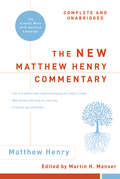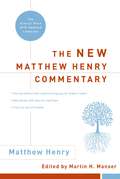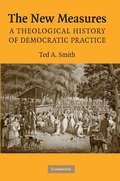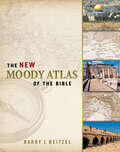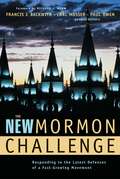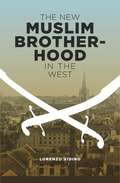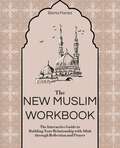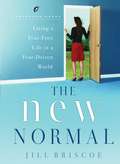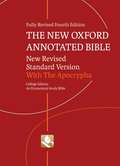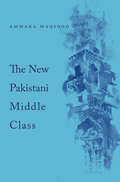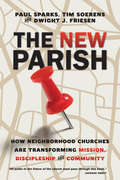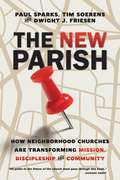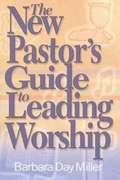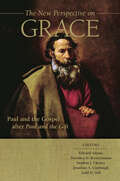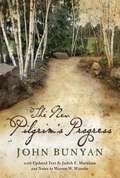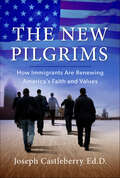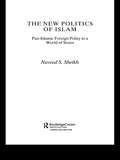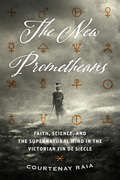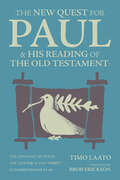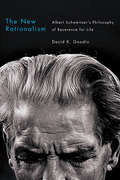- Table View
- List View
The New Matthew Henry Commentary: Complete and Unabridged
by Matthew Henry Martin H. ManserMatthew Henry (1662-1714) was a Presbyterian minister in England who began his commentary on the Bible in 1704. He completed his work up to the end of Acts before his death. Afterwards, his ministerial friends completed the work from Henry’s notes and writings. Time has sealed the reputation of Matthew Henry’s classic commentary as a rich source of insight into God’s word. For nearly 300 hundred years, Christian have consulted its rich insights into the very heart of God’s Word. Passage by passage, its prayerful, penetrating reflections inspire and challenge the reader. And now, in the tradition of the updated versions of Streams in the Desert and My Utmost for His Highest, the New Matthew Henry Commentary updates the language of the original, making it much easier to understand, while retaining its beauty and strong content. This one volume contains a wealth of exposition and comment, metaphors, analogies, and illustrations that have set Matthew Henry’s Commentary apart as one of the enduring legacies of faith. Ideal for personal devotions, Bible study, sermon and lesion preparations. Forever fresh and never failing to render new pearls of wisdoms, it’s a book you will reach for often to obtain deeper understanding of the Scriptures. Abridged and unabridged editions.
The New Matthew Henry Commentary: The Classic Work with Updated Language
by Matthew Henry Martin H. ManserA classic commentary in modern language … this volume contains the wealth of exposition, metaphors, analogies, and illustrations that have set Matthew Henry’s Commentary apart as one of the enduring legacies of faith—and presents them in the language of today. Passage by passage, its prayerful, penetrating reflections and rich insights into the very heart of God’s Word are sure to challenge and inspire you. Ideal for personal devotions, Bible studies, and lesson and sermon preparations, The New Matthew Henry Commentary will enable you to rediscover this classic work—or discover it for the first time. Forever fresh and never failing to render new pearls of wisdom, this beloved text is one that you will reach for often to obtain deeper understanding of and appreciation for the Scriptures.
The New Measures: A Theological History of Democratic Practice
by Ted A. SmithCombining histories of performance, space, institutions, and ideas, the book tells the story of the 'new measures' that circulated in the religious revivals of the 1820s and '30s.
The New Middle Ages
by Jerold C. FrakesBroadens the perspective of recent work on the discourse of the Muslim Other in medieval Christendom by investigating pertinent texts, art, and artefacts, situating these local discourses of the Muslim Other in the larger cultural context of proto-Eurocentric discourse.
The New Moody Atlas of the Bible
by Barry J. BeitzelThe Moody Atlas of Bible Lands integrates the geography of Bible lands with the teachings of the Bible. Its one hundred thousand words provide useful commentary for more than ninety detailed maps of Palestine, the Mediterranean, the Near East, the Sinai, and Turkey. Learn of God's protection and guidance by following Israel's forty-year sojourn in the wilderness. Appreciate the results of the Great Commission to 'teach all nations' by seeing the scope of Paul's three missionary journeys. Dr. Barry Beitzel has blended the topographical and historical in multi-colored maps that accurately reflect evangelical Christianity. Pages of timeless information aid in sermon preparation and in personal Bible study. The Moody Atlas of Bible Lands is an invaluable asset to Sunday school teachers and to seminary and Bible college students. Text and unique maps make this one of the most useful and accurate atlases available today.
The New Moody Atlas of the Bible
by Barry J. BeitzelThe Moody Atlas of Bible Lands integrates the geography of Bible lands with the teachings of the Bible. Its one hundred thousand words provide useful commentary for more than ninety detailed maps of Palestine, the Mediterranean, the Near East, the Sinai, and Turkey. Learn of God's protection and guidance by following Israel's forty-year sojourn in the wilderness. Appreciate the results of the Great Commission to 'teach all nations' by seeing the scope of Paul's three missionary journeys. Dr. Barry Beitzel has blended the topographical and historical in multi-colored maps that accurately reflect evangelical Christianity. Pages of timeless information aid in sermon preparation and in personal Bible study. The Moody Atlas of Bible Lands is an invaluable asset to Sunday school teachers and to seminary and Bible college students. Text and unique maps make this one of the most useful and accurate atlases available today.
The New Mormon Challenge: Responding to the Latest Defenses of a Fast-Growing Movement
by Francis J. Beckwith Richard J. Mouw Carl Mosser Paul OwenCurrent facts about Mormonism •Over 11 million members. •Over 60,000 full-time missionaries—more than any other single missionary-sending organization in the world. •More than 310,000 converts annually. •As many as eighty percent of converts come from Protestant backgrounds. (In Mormon circles, the saying is, “We baptize a Baptist church every week.”) •Within fifteen years, the numbers of missionaries and converts will roughly double. •Within eighty years, with adherents exceeding 267 million, Mormonism could become the first world-religion to arise since Islam. You may know the statistics. What you probably don’t know are the advances the Church of Jesus Christ of Latter-day Saints (LDS) is making in apologetics and academic respectability. With superb training, Mormon scholars outclass many of their opponents. Arguments against Mormon claims are increasingly refuted as outdated, misinformed, or poorly argued. The New Mormon Challenge is a response to the burgeoning challenge of scholarly Mormon apologetics. Written by a team of respected Christian scholars, it is free of caricature, sensationalism, and diatribe. The respectful tone and responsible, rigorous, yet readable scholarship set this book in a class of its own. The New Mormon Challenge recycles no previous material and duplicates no one’s efforts. Instead, responding to the best LDS scholarship, it offers freshly researched and well-documented rebuttals of Mormon truth claims. Most of the chapter topics have never been addressed, and the criticisms and arguments are almost entirely new. But The New Mormon Challenge does not merely challenge Mormon beliefs; it offers the LDS Church and her members ways to move forward. The New Mormon Challenge will help you understand the intellectual appeal of Mormonism, and it will reveal many of the fundamental weaknesses of the Mormon worldview. Whether you are sharing the gospel with Mormons or are investigating Mormonism for yourself, this book will help you accurately understand Mormonism and see the superiority of the historic Christian faith. Outstanding scholarship and sound methodology make this an ideal textbook. The biblical, historical, scientific, philosophical, and theological discussions are fascinating and will appeal to Christians and Mormons alike. Exemplifying Christian scholarship at its best, The New Mormon Challenge pioneers a new genre of literature on Mormonism. The Editors Francis J. Beckwith (Ph.D., Fordham University), Carl Mosser (Ph.D. candidate, University of St. Andrews), and Paul Owen (Ph.D., University of Edinburgh) are respected authorities on the Church of Jesus Christ of Latter-day Saints and the authors of various books and significant articles on Mormonism. Their individual biographies as well as information on the book’s contributors appear inside. With contributors including such respected scholars as Craig L. Blomberg, William Lane Craig, J. P. Moreland, and others, The New Mormon Challenge is, as Richard Mouw states in his foreword, “an important event for both Protestant evangelicals and Mormons” that models “to the evangelical community what it is like to engage in respectful and meaningful exploration of a viewpoint with which we disagree on key points.” “In recent years, Mormon scholars have produced a body of literature that has been largely ignored by evangelicals. This current volume takes a giant step forward in correcting this oversight in a way that is both intellectually vigorous, yet respectful.” —Ken Mulholland, President, Salt Lake Theological Seminary “Intellectually serious evangelical responses to the faith of the Latter-day Saints have been depressingly rare. This book represents a significant contribution to a conversation that, really, has just begun.” —Daniel Peterson, Brigham Young University; Foundation for Ancient Research and Mormon Studies (FARMS) “Finally we have a book from evangelicals in which the authors have made
The New Muslim Brotherhood in the West
by Lorenzo VidinoIn Europe and North America, networks tracing their origins back to the Muslim Brotherhood and other Islamist movements have rapidly evolved into multifunctional and richly funded organizations competing to become the major representatives of Western Muslim communities and government interlocutors. Some analysts and policy makers see these organizations as positive forces encouraging integration. Others cast them as modern-day Trojan horses, feigning moderation while radicalizing Western Muslims. Lorenzo Vidino brokers a third, more informed view. Drawing on more than a decade of research on political Islam in the West, he keenly analyzes a controversial movement that still remains relatively unknown. Conducting in-depth interviews on four continents and sourcing documents in ten languages, Vidino shares the history, methods, attitudes, and goals of the Western Brothers, as well as their phenomenal growth. He then flips the perspective, examining the response to these groups by Western governments, specifically those of Great Britain, Germany, and the United States. Highly informed and thoughtfully presented, Vidino's research sheds light on a critical juncture in Muslim-Western relations.
The New Muslim Brotherhood in the West (Columbia Studies in Terrorism and Irregular Warfare)
by Lorenzo VidinoIn Europe and North America, networks tracing their origins back to the Muslim Brotherhood and other Islamist movements have rapidly evolved into multifunctional and richly funded organizations competing to become the major representatives of Western Muslim communities and government interlocutors. Some analysts and policy makers see these organizations as positive forces encouraging integration. Others cast them as modern-day Trojan horses, feigning moderation while radicalizing Western Muslims. Lorenzo Vidino brokers a third, more informed view. Drawing on more than a decade of research on political Islam in the West, he keenly analyzes a controversial movement that still remains relatively unknown. Conducting in-depth interviews on four continents and sourcing documents in ten languages, Vidino shares the history, methods, attitudes, and goals of the Western Brothers, as well as their phenomenal growth. He then flips the perspective, examining the response to these groups by Western governments, specifically those of Great Britain, Germany, and the United States. Highly informed and thoughtfully presented, Vidino's research sheds light on a critical juncture in Muslim-Western relations.
The New Muslim Workbook: The Interactive Guide to Building Your Relationship with Allah through Reflection and Prayer
by Bisma ParvezA Simon & Schuster eBook. Simon & Schuster has a great book for every reader.
The New Muslims of Post-Conquest Iran
by Sarah Bowen SavantHow do converts to a religion come to feel an attachment to it? The New Muslims of Post-Conquest Iran answers this important question for Iran by focusing on the role of memory and its revision and erasure in the ninth to eleventh centuries. During this period, the descendants of the Persian imperial, religious, and historiographical traditions not only wrote themselves into starkly different early Arabic and Islamic accounts of the past but also systematically suppressed much knowledge about pre-Islamic history. The result was both a new "Persian" ethnic identity and the pairing of Islam with other loyalties and affiliations, including family, locale, and sect. This pioneering study examines revisions to memory in a wide range of cases, from Iran's imperial and administrative heritage to the Prophet Muhammad's stalwart Persian companion, Salman al-Farisi, and to memory of Iranian scholars, soldiers, and rulers in the mid-seventh century. Through these renegotiations, Iranians developed a sense of Islam as an authentically Iranian religion, as they simultaneously shaped the broader historiographic tradition in Arabic and Persian.
The New Normal: Living a Fear-Free Life in a Fear-Driven World (LifeChange Books)
by Jill BriscoeTwin Towers Down, New Hope on the Rise When the Twin Towers fell, a whole new world of fear and doubt emerged. "Where is God in all of this?" we ask. To be constantly on guard against terrorist attacks, not to mention crises that hit us on a personal level, is exhausting. But in the midst of this "new normal" world of fear, one thing remains the same: God still reigns. While we may be tempted to turn to food, shopping, busyness, even family, God is the only answer we can count on. He is our source for peace, comfort, and confidence in the midst of chaos. Jill Briscoe encourages the hurting and weary to run unencumbered into the arms of God. And this all-encompassing peace that may seem so elusive right now will become yours to stay. Escape Fear Expand Faith Embrace the Future Where is God in the midst of our world's catastrophic events? Where is God in the midst of our deepest pain? We may think we're getting along with God, until a 9/11 happens. Global or personal, tragedy wreaks havoc on our souls. How are you supposed to trust the One letting it all happen? The New Normalwon't give you pat answers. But it will guide you to a place of security in the face of inexplicable calamity. By being honest about your anxieties, willing to respond to God's instruction, and ready to take a leap of faith, you'll find a new, hope-filled future waiting for you. It's the new normal you've been longing for. Story Behind the Book "I was in the air on September 11, 2001 . More than anything for me, the event served as a wake up call to evangelism," says Briscoe. "I realized the time is short and the days are evilhellip;the Lord is coming soon! So let's seize the day!" Based on a sermon she gave at Elmbrook Church soon after that day etched itself in history, The New Normal speaks to an America in shock, but with a message that is even more pertinent today.
The New Oxford Annotated Bible with Apocrypha (4th Edition)
by Michael D. Coogan Pheme Perkins Carol A. Newsom Marc Z. BrettlerThe premier study Bible used by scholars, pastors, undergraduate and graduate students, The New Oxford Annotated Bible offers a vast range of information, including extensive notes by experts in their fields; in-text maps, charts, and diagrams; supplementary essays on translation, biblical interpretation, cultural and historical background, and other general topics.
The New Pakistani Middle Class
by Ammara MaqsoodImages of religious extremism and violence in Pakistan—and the narratives that interpret them—inform global events but also twist back to shape local class politics. Ammara Maqsood focuses on life in Lahore, where she untangles these narratives to show how central they are for understanding competition between middle-class groups.
The New Parish: How Neighborhood Churches Are Transforming Mission, Discipleship and Community
by Paul Sparks Tim Soerens Dwight J. Friesen2015 Christianity Today Award of Merit (The Church/Pastoral Leadership)2014 Readers' Choice Awards Honorable Mention2014 Best Books About the Church from Byron Borger, Hearts and Minds Bookstore
The New Parish: How Neighborhood Churches are Transforming Mission Discipleship and Community
by Paul Sparks Tim Soerens Dwight J. FriesenPaul Sparks, Tim Soerens and Dwight J. Friesen have seen―in cities, suburbs and small towns all over North America―how powerful the gospel can be when it takes root in the context of a place, at the intersection of geography, demography, economy and culture. This is not a new idea―the concept of a parish is as old as Paul's letters to the various communities of the ancient church. But in an age of dislocation and disengagement, the notion of a church that knows its place and gives itself to where it finds itself is like a breath of fresh air, like a sign of new life.
The New Pastor's Guide to Leading Worship
by Barbara Day MillerWorshipA down-to-earth guide to planning and implementing meaningful worship experiences for pastors, written especially for those new to the job.This practical book is for new pastors as they move into the role of worship leader and planner. When faced with the weekly rhythm of planning and leading worship, new pastors sometimes find themselves overwhelmed with the tasks. The book centers on the pastor and his/her identity as worship leader, on guidelines for leadership, and on the 'why' and 'how' of worship services. Contents include: The Pastor as Leader; Leading on Your First Sunday; Rituals: "The way we do it here"; Leading in the Worship Service; Leading Prayer; Leading Communion; Leading Baptism; Leading through the Christian Year; Leading with Musicians; Leading the People into Leadership.To read chapter oneclick here"I heartily commend this book to new pastors. Get it and read it before you show up at your first appointment. Barbara Day Miller will save you from many a heartache and embarrassment. Though tagged as a new pastor's guide, most pastors I know will benefit by reading the New Pastor's Guide, especially the latter chapters about leading with musicians and guiding members of the congregation into worship leadership."Reverend Daniel T. Benedict, Jr., Director of Worship Resources, General Board of Discipleship, United Methodist Church"In the past couple of years, I have worshipped in about a hundred congregations. After that experience, I can tell you, HERE IS THE BOOK WE NEED! Barbara Day Miller packs this little book with a lifetime of the creative worship leadership and the inspired preparation of pastors to lead worship. Combining practical help with a deep theological understanding of, and heartfelt love of Christian worship, she gives pastors everything they need to lead God's people in prayer and praise."William H. Willimon, Bishop, the North Alabama Conference of the United Methodist Church. Barbara Day Miller is the Assistant Dean of Worship at Candler School of Theology in Atlanta, Georgia.Church & Ministry/Church Life//Worship/Liturgy
The New Perspective on Grace: Paul and the Gospel after Paul and the Gift
by Edward Adams, Dorothea H. Bertschmann, Stephen J. Chester, Jonathan A. Linebaugh, and Todd D. Still, eds.For those inspired by Barclay&’s Paul and the Gift Over the course of his academic career, John M. G. Barclay has transformed how we think about Paul. Barclay&’s contributions to Pauline Studies reached a new height with the publication of his award-winning Paul and the Gift, in which he presents a sophisticated reading of Paul&’s theology of grace within the context of gift-giving in the Greco-Roman world. But where does Pauline scholarship go from here? Featuring a diverse group of internationally renowned scholars, The New Perspective on Grace collects essays inspired by Barclay&’s magnum opus. These essays broadly explore the implications of grace and gift across a variety of fields: biblical studies, theology, reception history, and theology in practice. Topics include: • Paul&’s soteriology • The role of grace in Paul&’s life and ministry • Implications of the New Perspective on Paul • Divine giving in the Gospels • Gift-giving and Christian aesthetics • Interpretations of Pauline grace from the patristic period to the present • Self-giving and self-care • Grace and ministry in marginalized communities The New Perspective on Grace is essential reading for all students and scholars who want to understand the current state of Pauline scholarship.Contributors: Edward Adams, Dorothea H. Bertschmann, Ben C. Blackwell, David Briones, Marion L. S. Carson, Stephen J. Chester, Susan Grove Eastman, Troels Engberg-Pedersen, Simon Gathercole, Beverly Roberts Gaventa, John K. Goodrich, Judith M. Gundry, Jane Heath, David G. Horrell, Jonathan A. Linebaugh, Joel Marcus, Orrey McFarland, Dean Pinter, Todd D. Still, Paul Trebilco, Michael Wolter
The New Pete (Jennifer #9)
by Jane SorensonJennifer returns from Haiti to find that her brother Pete has a radical new image. Justin tells her that Pete made a decision not to be a wimp anymore, and the rad appearance is part of his plan. Later, Pete confides to Jennifer that he wants to fit in at school and be popular. He begins to study a book, and to practice the popularity techniques in it on his family. After a short time with the in-crowd, Pete discovers that they are more cruel than cool and that he really doesn't enjoy "belonging." Then he finds a place where he really fits in, gets another new look, and a girl friend. It all adds up to The New Pete."
The New Pilgrim's Progress
by John Bunyan Judith E. MarkhamBunyan's allegory has been translated into more than 100 languages and enjoyed by millions of all ages and backgrounds. Now you can enjoy a revised edition that retains Bunyan's style and form, while translating archaic words, phrases, and expressions into modern English. When you read The New Pilgrim's Progress, you will discover that both this enduring classic and your Bible will read like new books to you.
The New Pilgrims: How Immigrants are Renewing America's Faith and Values
by Joseph CastleberryWe often assume America needs to help immigrants, but in The New Pilgrims, Joseph Castleberry opens our eyes to how the opposite is true, and how we can join in one of the greatest spiritual movements this country has ever seen.In the midst of an apparent religious decline in the United States, many Americans are looking for solutions to this dilemma. Our hope lies with Christian immigrants, who bring to our churches powerful testimonies of faith from cultures all over the world. As the "new pilgrims" settle into their lives here, they are taking the American church by storm and helping rebuild America's conservative foundations.It's time to acknowledge this exciting time of spiritual renewal and embrace the political and relational choices that will once again establish America as the "shining city on a hill" we all want it to be.
The New Politics of Islam: Pan-Islamic Foreign Policy in a World of States (Routledge Islamic Studies Series)
by Naveed S. SheikhThis is a timely study of the international relations of Islamic states, dealing both with the evolving theory of pan-Islamism from classical to post-caliphal times and the foreign-policy practice of contemporary states, especially Saudi Arabia, Iran and Pakistan, from the colonial period to the global aftermath of September 11. With a concise but analytic style, the book engages one-by-one with the questions of political theory, political geography and political sociology as they relate to international Islam. Its primary empirical investigation is centred on the Organization of the Islamic Conference (OIC), a powerful pan-Islamic regime, sometimes referred to as the 'Muslim United Nations'. In its theoretical deliberations on Islam and the postmodern condition, the book reconstructs contemporary understandings of how religious ideas and identities influence international politics in the Islamic world.
The New Prometheans: Faith, Science, and the Supernatural Mind in the Victorian Fin de Siècle
by Courtenay Raia PhDThe Society for Psychical Research was established in 1882 to further the scientific study of consciousness, but it arose in the surf of a larger cultural need. Victorians were on the hunt for self-understanding. Mesmerists, spiritualists, and other romantic seekers roamed sunken landscapes of entrancement, and when psychology was finally ready to confront these altered states, psychical research was adopted as an experimental vanguard. Far from a rejected science, it was a necessary heterodoxy, probing mysteries as diverse as telepathy, hypnosis, and even séance phenomena. Its investigators sought facts far afield of physical laws: evidence of a transcendent, irreducible mind. The New Prometheans traces the evolution of psychical research through the intertwining biographies of four men: chemist Sir William Crookes, depth psychologist Frederic Myers, ether physicist Sir Oliver Lodge, and anthropologist Andrew Lang. All past presidents of the society, these men brought psychical research beyond academic circles and into the public square, making it part of a shared, far-reaching examination of science and society. By layering their papers, textbooks, and lectures with more intimate texts like diaries, letters, and literary compositions, Courtenay Raia returns us to a critical juncture in the history of secularization, the last great gesture of reconciliation between science and sacred truths.
The New Quest for Paul & His Reading of the Old Testament: The contrast between the "Letter" & the "Spirit" in 2 Corinthians 3:1-18
by Timo LaatoThe author is known as a strong opponent of the so-called New Perspective on Paul. In this book, he seeks to move beyond that debate and open new vistas in Pauline research. There is a need for much revision. The author first dives in to a detailed exegetical study of 2 Corinthians 3, a chapter that has a reputation of being an exegetical nightmare. He examines the interpretational problems associated with the opposition between the letter that kills and the Spirit that gives life. Fresh insights emerge. Ultimately, the whole issue turns on the question whether to understand the Old Testament ac cord ing to the "literal-letteral" or "literal-spiritual" sense. As a consequence, Paul breaks up with Ju da ism and pulls down the works of the law since he competes against the view of observing the Torah "in flesh" and ac cording to the "literal-letteral" meaning of the text. He regards such a reli gious pur suit as the worst form of human self-righteousness and self-praise (despite the serious efforts to true piety). On the other hand, Christians have undergone a transformation in terms of re-creation, rege neration, resusci tation, resur rec tion, or revitalization. The Spirit gives them life. He reigns in them. Hence, Christians do fulfill the whole Mosaic law. Yet, they fulfill it "in Spirit" and not "in flesh," in other words, according to the "literal-spiritual" and not "literal-letteral" sense of Scripture. As a consequence, they do not bolster their self-righteousness and self-praise. To corroborate his the sis, the author draws on similar wordings in other Pauline letters and several passages in the Old Tes ta ment from Exodus, Jeremiah, and Ezekiel. The author concludes that the New Perspec tive on Paul has run its course. A New Quest for Paul is needed. Therefore, this book is needed.
The New Rationalism
by David K. GoodinAlbert Schweitzer (1875-1965) preached a message of reverence for life - all life - that touched the hearts of a generation. As a medical doctor in French Equatorial Africa who selflessly helped those in need, Schweitzer was recognized with the Nobel Peace Prize in the wake of two world wars. But less than fifty years since the time of his death, the great humanitarian and scholar has faded from public awareness. In The New Rationalism, David Goodin explores the underlying philosophy behind Schweitzer's ethic of compassion, presenting it as a response to contemporary questions in social justice, economic equality, and environmental action. For the first time, the political, sociological, and philosophical contexts supporting the development of Schweitzer's ethic are examined in order to bring his timeless message of elemental morality to new life for the modern world. Inspired by Arthur Schopenhauer and Friedrich Nietzsche, Schweitzer built his ethic to create an elemental nature philosophy compatible with empirical science, and to support a new ontological understanding of the human person - a project he termed the New Rationalism. Goodin recovers and analyzes Schweitzer's arguments and shows where his theories can provide a framework for both environmental and civic ethics today.
